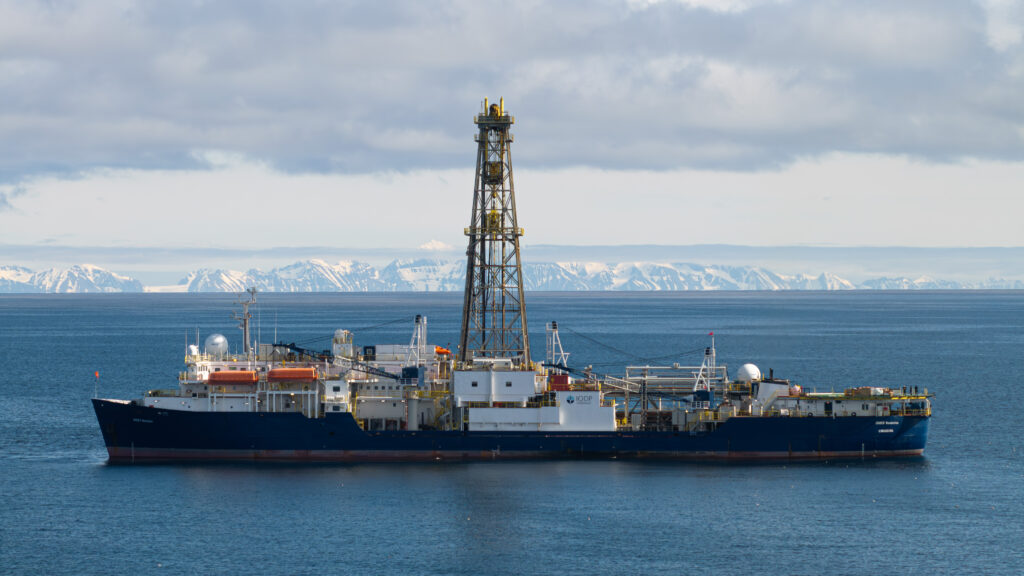
International Ocean Discovery Program drill ship, the JOIDES Resolution, sitting off the coast of Svalbard during Expedition 403. PC: Chris Lyons, JRSO Outreach.
Expedition 403
Floating off the west coast of Svalbard, a ship with 24 scientists from countries around the world waits to hear a familiar phrase ring over the intercom. “Core on deck!” jolts the crew into action, informing them that new sub-seafloor treasures have made their way to the drill floor. With no days off for two months, scientists, technicians, engineers, drillers, and staff, work 12-hour shifts to ensure there is always a team ready to handle the new core samples.
Highlight: “…the past can help us understand what is happening and what will happen in the future in the Arctic.” – Dr. Katrine Husum
Located between Greenland and Svalbard, the Fram Strait serves as a gateway for ocean currents to exchange water between the Arctic and North Atlantic Oceans. Scientists are studying this special gateway, as it plays a large role in regional and global climate change. Heat, salt, and moisture are brought to the Arctic region through a northward-flowing current system, influencing ocean circulation patterns as well as the melting and formation of ice sheets and sea ice.
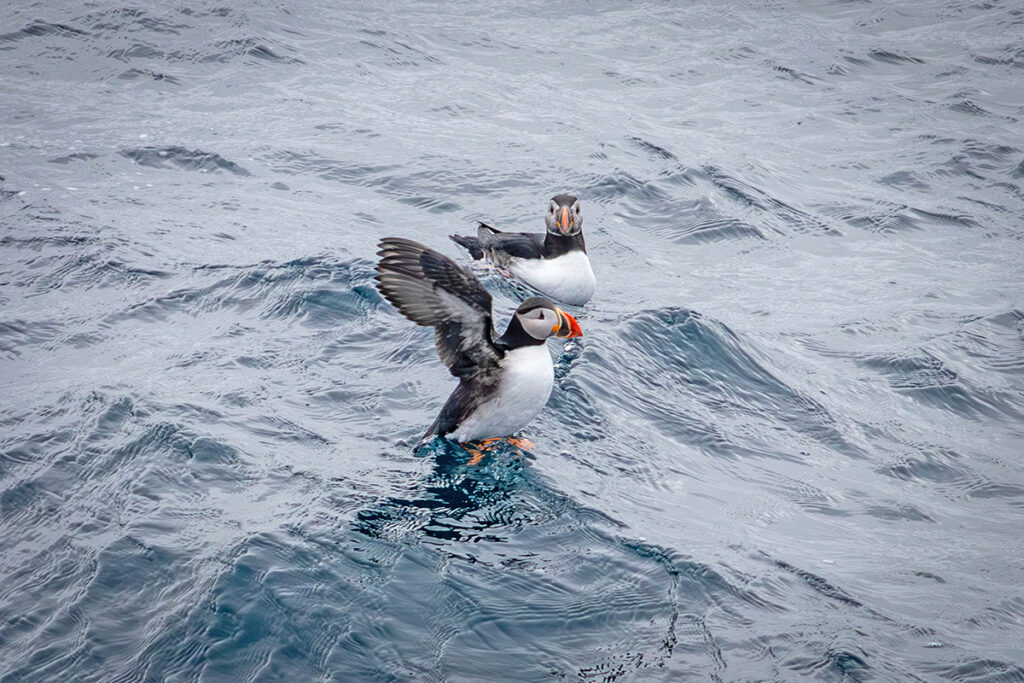
Puffins in the waters off the coast of Svalbard. PC: Thomas Ronge, IODP.
As part of International Ocean Discovery Program Expedition 403, the JOIDES Resolution, a US drill ship, is currently coring sediments from thick seafloor deposits that have accumulated over millions of years. These seafloor deposits, called sediment drifts or contourites, are shaped by deep ocean currents and are fed by marine biological debris and sediments transported from advancing and retreating glaciers located on nearby continents. These drift deposits hold a record of past oceanographic and climate conditions by providing a detailed history of ocean-ice interactions during significant global climate transitions. Expedition 403 is exploring the Fram Strait to take a closer look at the previously existing Svalbard-Barents Sea Ice Sheet and climate transitions such as the onset of Northern Hemisphere glaciation and past periods of rapid warming when levels of atmospheric CO2 were higher than present day. This climate data is crucial in validating predictive models that project future CO2 levels, global temperatures, and ice sheet stabilities.
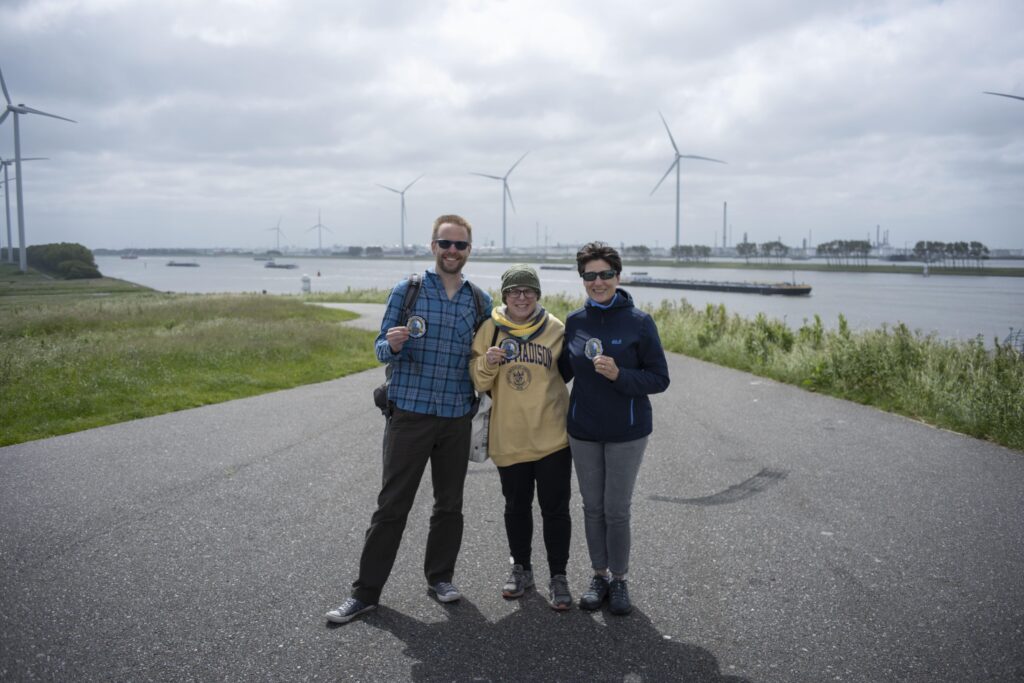
Expedition 403 project manager and co-chiefs before departure in Rotterdam, The Netherlands. From left to right: Expedition Project Manager Thomas Ronge, Texas A&M University, USA; Co-Chief Kristen St. John, James Madison University, USA; and Co-Chief Renata Lucchi, Istituto Nazionale di Oceanografia e di Geofisica Sperimentale, Italy. PC: Khyber Jones, IODP Outreach.
When one of the Expedition 403 co-chiefs, Dr. Renata Lucchi, was asked about the motivation for the expedition, she explained:
“I work on the reconstruction of depositional processes in polar areas deriving from the interaction between climate-ocean-cryosphere. The reconstruction of the dynamics of the paleo Svalbard-Barents Sea Ice Sheet under different climate/ocean forcing is important to extract the key information that can help us to better forecast the behavior of other modern marine-based ice sheets such as the West Antarctic Ice Sheet whose loss of stability under the present global warming is one of the main uncertainties to forecast future global sea level rise”.
An Inside Look at the Sediment Core Flow

Technicians work to clean and section cores on the catwalk while geochemical samples are collected. From left to right: Marine Laboratory Specialist Daniel Rudback, Texas A&M University, USA; Organic Geochemist Mutsumi Iizuka, The National Institute of Advanced Industrial Science and Technology, Japan; Marine Laboratory Specialist Brittany Stockmaster, Texas A&M University, USA; Marine Laboratory Specialist Max Witek, Texas A&M University, USA; Assistant Laboratory Officer Dan Marone, Texas A&M University, USA. PC: Khyber Jones, IODP Outreach.
While the shipboard scientists are focused on processing samples and collecting data, laboratory technicians work behind the scenes to ensure this work is possible. Sediment cores are collected from the seafloor in plastic tubes and handed directly to technical staff from the drill floor to the core receiving platform, better known as the catwalk. On the catwalk, cores are cleaned, cut into sections, capped, measured, and labeled before being brought to the laboratory.
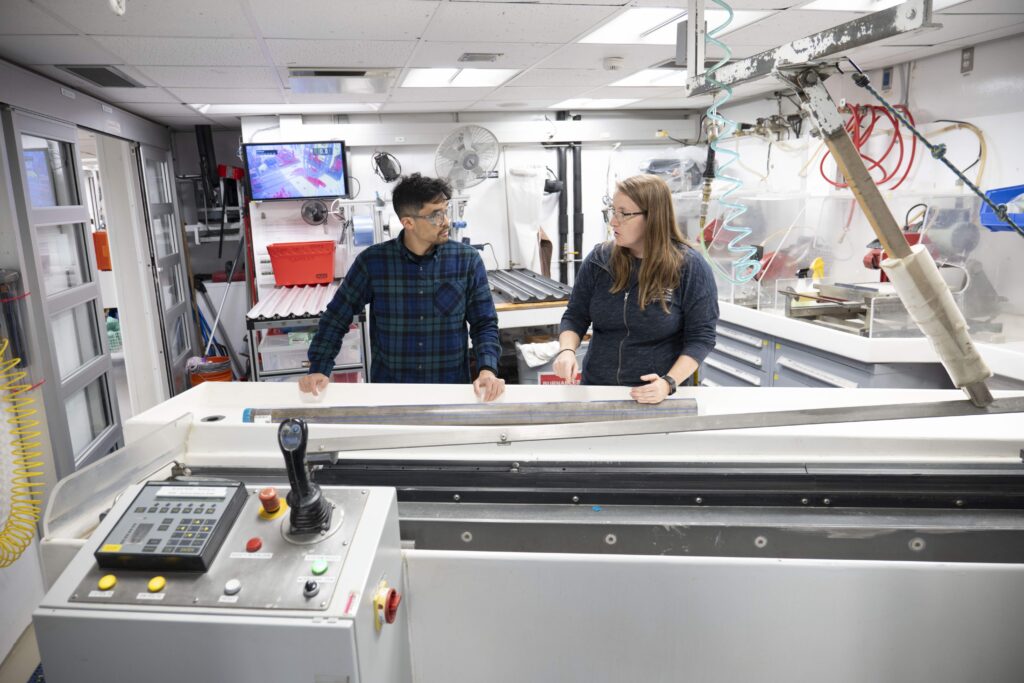
Texas A&M University Marine Laboratory Specialist Jesse Yeon and Assistant Laboratory Officer Beth Novak in the core splitting room. PC: Khyber Jones, IODP Outreach.
The internal temperatures of sediment cores must equilibrate prior to physical property analysis and are placed on racks for up to four hours, waiting to be split and passed on to the scientists. Once the temperatures equilibrate and the physical property team scans the cores for natural gamma radiation and magnetic susceptibility measurements, laboratory technicians split the cores into a working half and an archive half. The working half is used for shipboard and post-cruise sampling, while archive halves are handed off to the sedimentology team for X-raying, photographing, completing a visual core description on each section, and scanning for color reflectance and magnetic susceptibility point measurements.
Meet the Scientists of Expedition 403
After geochemical and microbiological samples are collected on the catwalk, the first scientists to handle new sediment cores in the laboratory are the Physical Properties team, who explained:
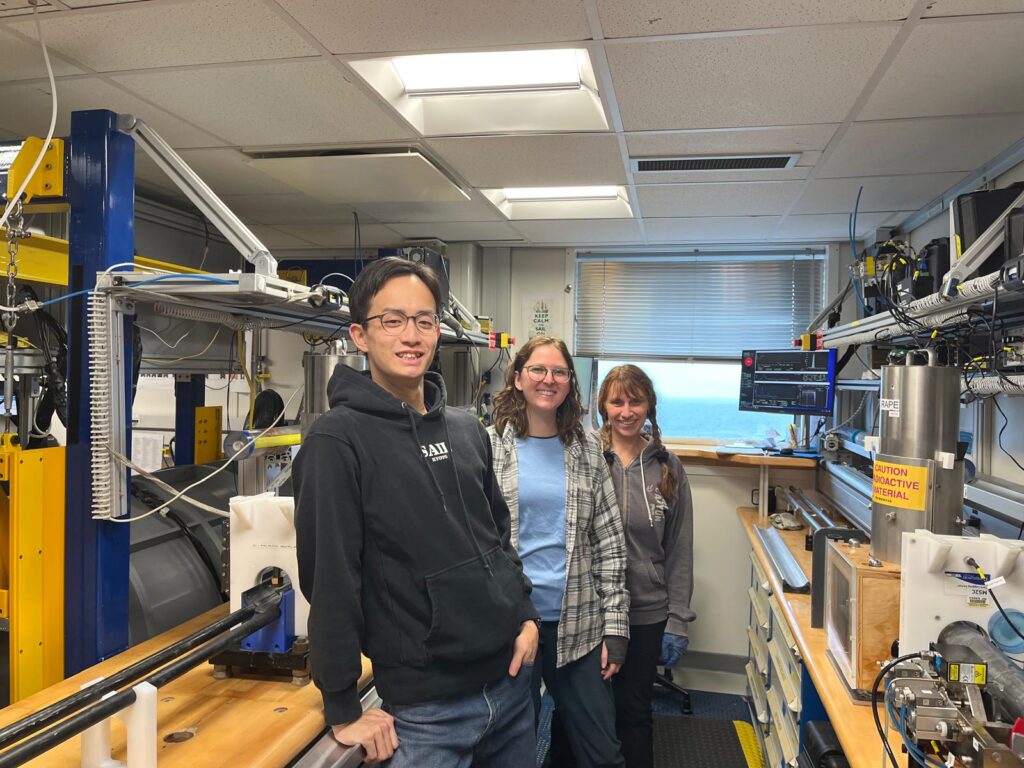
Expedition 403 Physical Properties team. From left to right: Yuhi Sakai, Kyoto University Graduate School of Engineering, Japan; Lindsey Monito, University of Florida, USA; and Olga Libman-Roshal, Montclair State University, USA.
“The Physical Properties team uses several scanners to look at every core before it is even split! The core liner is see-through, but we are the first to really “see” the mud. We measure the sediment’s density, the amount of magnetic material, and more. These properties can track chemical processes that occur on the ocean floor or even changes in sediment carried from land. Back on land in their labs, Olga and Lindsey will use the magnetic material from these cores to investigate how the ocean and Svalbard-Barents Sea Ice Sheet (SBSIS) responded to past changes in Earth’s climate and when those changes happened. Yuhi will analyze the results of his onboard tectonics experiment to get evidence of how seabed formation is physically responding to melting SBSIS. One scan, one sample at a time, we get closer to knowing what the Arctic looked like millions of years ago!” – Yuhi Sakai, Lindsey Monito, and Olga Libman-Roshal.
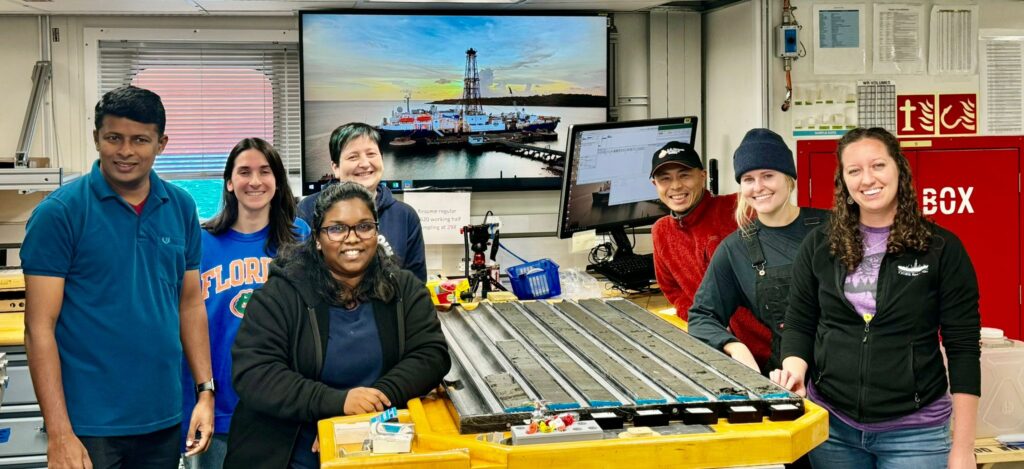
The Expedition 403 Sedimentology team. From left to right: Sijin Veedu, Central University of Kerala, India; Nicole Greco, University of Florida, USA; Isuri Kapuge, University of Delaware, USA; Catalina Gebhardt, Alfred Wegener Institute Helmholtz-Center for Polar and Marine Research, Germany; Yusuke Suganuma, National Institute of Polar Research, Japan; Gryphen Goss, Yale University, USA, Adriane Lam; Binghamton University, USA.
After cores are split, they’re handed off to a team of sedimentologists for detailed description.
“Characterizing the color, texture, and composition of recovered sediments is one of the most important jobs of the Sedimentology lab. In the Arctic region, this data will be used to interpret glacial versus interglacial periods, or times with expansive glaciers and ice sheets versus warmer periods when the ice was melted back. Sediments and rocks are transported to the ocean through various mechanisms including iceberg rafting, meltwater plumes, and debris flows, which all provide information on the past climate in the high latitudes.” – Isuri Kapuge, Dr. Adriane Lam, and Dr. Nicole Greco.
Detailed and accurate description of the sediment cores is not only important for shipboard analyses, but also becomes the primary information used by future scientists when determining which cores to take samples from for their personal research.
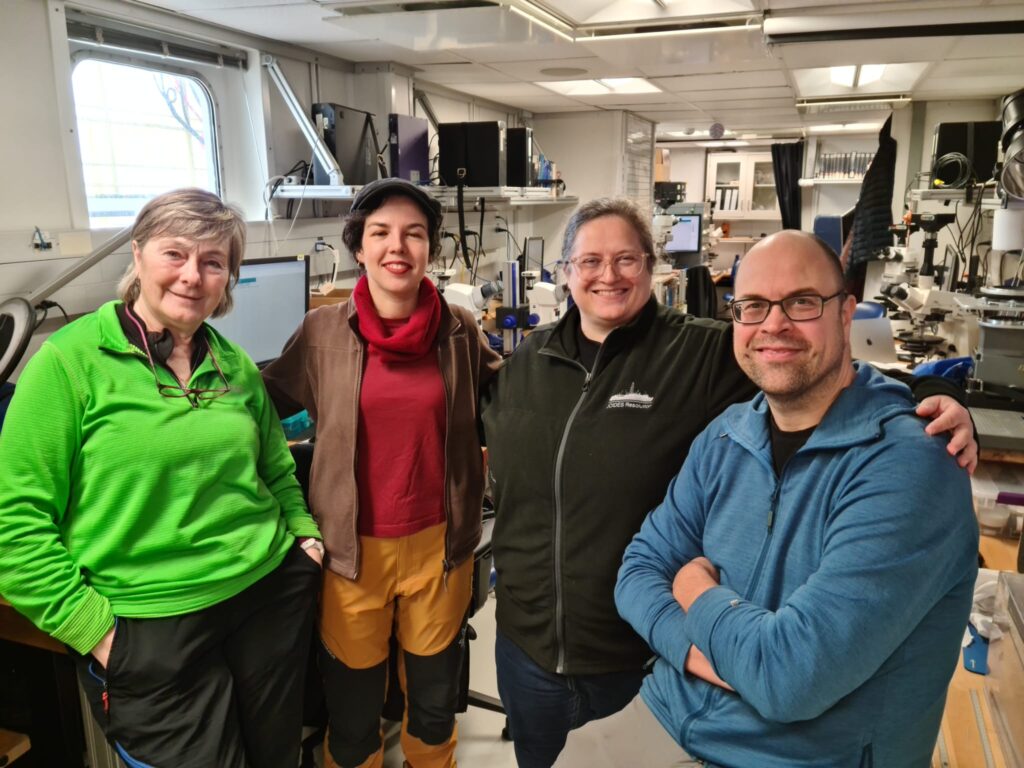
Expedition 403 Micropaleontologists. From left to right: Maria A. Barcena, University of Salamanca, Spain; Alba Gonzalez-Lanchas, University of Oxford, United Kingdom; Katrine Husum, Norwegian Polar Institute, Norway; Stijn De Schepper, NORCE Norwegian Research Centre AS, Norway.
Taking larger mud samples on the catwalk and smaller samples on the split cores for microscope analysis, the micropaleontology team searches for microfossils to determine the age of the sediments and reconstruct the climate when these organisms were alive. “The goal of the paleontology team is to find analogs in the past that can help us understand what is happening and what will happen in the future in the Arctic. Establishing baseline data from past warm climate periods will elucidate natural variability, which will help improve future climate modeling.” – Dr. Katrine Husum.
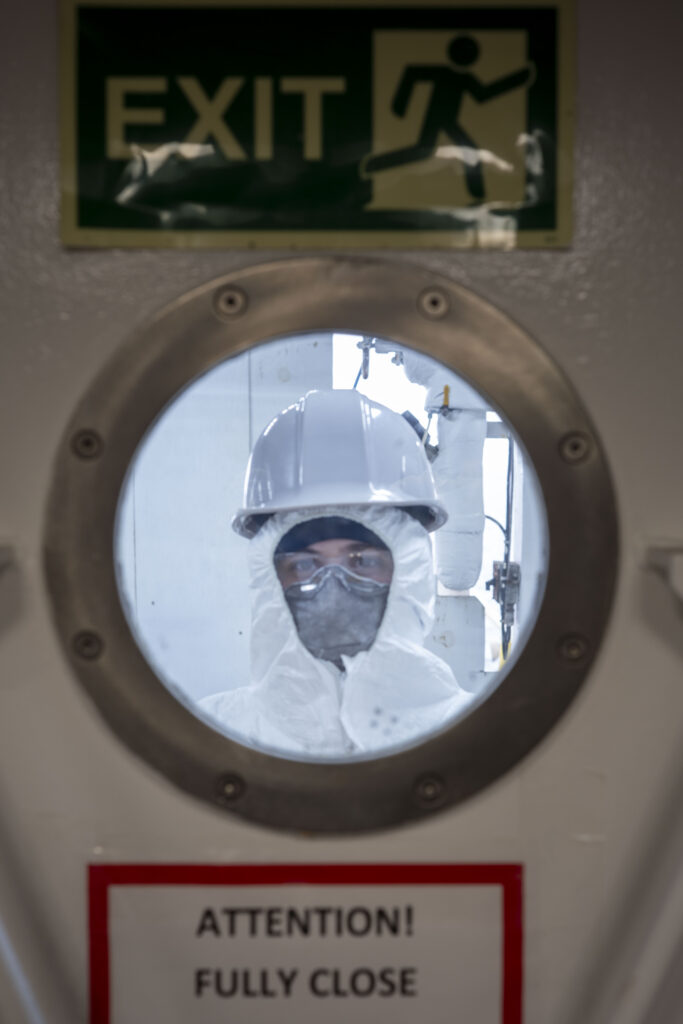
Microbiologist/Geochemist Lucinda Duxbury, Institute for Marine and Antarctic Studies, Australia, waiting to collect sediment samples on the catwalk for ancient DNA analysis. PC: Khyber Jones, IODP Outreach.
Splitting her time between the microbiology and geochemistry labs, Lucinda Duxbury focuses on even smaller details, like DNA. She explains: “I am extracting ancient DNA to reconstruct past marine biodiversity. It will tell us how marine ecosystems responded to climate change in the past, paying particular attention to periods of rapid warming that serve as analogs for future climate change. Microorganisms such as phytoplankton and zooplankton are essential for the carbon cycle and greenhouse gas cycling, which play into a warming climate.” -Lucinda Duxbury.
The final group to see the cores before they’re packed away for post-cruise transport is the Paleomagnetism team. When asked about their work, Dr. Yi Zhong explains: “For paleomagnetism research in the Arctic Ocean, the Earth’s field dynamics, dating chronology, and climatic changes are very important. Firstly, we aim to obtain a primary chronology scheme of recovered cores. Secondly, we use the relative paleointensity to determine Earth’s field dynamics. Lastly, we can use environmental magnetism to focus on the Atlantic water dynamics (e.g. directions, current intensity and sources)”.

The Expedition 403 Paleomagnetism team. Left: Yi Zhong, Southern University of Science and Technology, Shenzhen, China. Right: Brendan Reilly, Lamont-Doherty Earth Observatory, Columbia University, USA. PC: Isuri Kapuge, Sedimentologist.
Other shipboard teams include the geochemistry group (Mutsumi Iizuka, The National Institute of Advanced Industrial Science and Technology, Japan; Yanguang Liu, First Institute of Oceanography, China; Lauren Haygood, Oklahoma State University, USA) who are responsible for measuring headspace gas levels while drilling, and the stratigraphic correlation group (Jens Gruetzner, Alfred Wegener Institute Helmholtz-Center for Polar and Marine Research, Germany; Yair Rosenthal, Rutgers University, USA) who use physical properties measurements to match data from different drill holes within the same site. All shipboard scientists will conduct post-cruise research on samples collected during the cruise or at the post-cruise sampling party, hosted at the IODP Core Repository in Bremen, Germany 6 months after the expedition.
Over 2.6 miles (4.217 km) of core have been collected on Expedition 403, with one more week of coring planned.
After serving as the primary vessel for US scientific ocean drilling for over 3 decades, the JOIDES Resolution (JR) will be demobilized in August 2024, just after the conclusion of Expedition 403, marking the end of the International Ocean Discovery Program (IODP) due to a lack of funding support. Scientists around the world mourn the loss of the JR and the IODP, as the program has sparked the beginning of many scientist’s research careers and has been the catalyst for countless international collaborations throughout its history. The discontinuation of the IODP will undoubtedly impede progress in climate, oceanographic, and cryosphere research, which are crucial fields in our currently uncertain and changing environment.

PC: Isuri Kapuge, Sedimentologist
Written by Nicole Greco
Community Education and Outreach Coordinator, Arctic Data Center
With special help from the scientists and outreach team of Expedition 403
